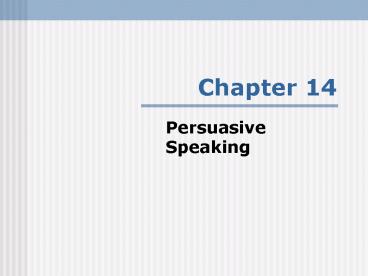Persuasive Speaking - PowerPoint PPT Presentation
1 / 22
Title:
Persuasive Speaking
Description:
the characteristics of persuasion and the ethical questions involved. ... Bandwagon appeal (argumentum ad populum) Adapting to the audience. Establish common ground ... – PowerPoint PPT presentation
Number of Views:46
Avg rating:3.0/5.0
Title: Persuasive Speaking
1
Chapter 14
- Persuasive Speaking
2
After studying the material in this chapter
- You should understand
- the characteristics of persuasion and the ethical
questions involved. - the differences among questions of fact, value,
and policy. - the difference between the goals of convincing
and actuating. - the difference between direct and indirect
approaches.
3
After studying the material in this chapter. . .
- the importance of setting a clear persuasive
purpose. - the basic idea of persuasive structure.
- the importance of analyzing and adapting to your
audience. - the components of personal credibility.
4
After studying the material in this chapter. . .
- You should be able to
- formulate an effective persuasive strategy to
convince, or actuate, an audience. - formulate a persuasive strategy based on ethical
guidelines. - bolster your credibility as a speaker by
enhancing your competence, character, and
charisma.
5
After studying the material in this chapter. . .
- build persuasive arguments through audience
analysis, solid evidence, and careful reasoning. - organize a persuasive speech for greatest
audience effect.
6
Chapter highlights
- Persuasion is the process of motivating someone,
through communication, to change a belief,
attitude, or behaviour. - Persuasion has several important characteristics
- Persuasion is not coercive.
- Persuasion is usually incremental.
- Persuasion is interactive.
- Persuasion can be ethical.
7
Chapter highlights
- Persuasion can be categorized according to the
following types - by type of proposition,
- by desired outcome
- by directness of approach.
8
Chapter highlights
- Preparing an effective persuasive speech can be
made easier by following a few simple rules - Set a clear persuasive purpose.
- Structure the message carefully.
- Use solid evidence.
- Avoid fallacies.
9
Chapter highlights
- Adapting to your audience is an important part of
persuasive strategy. To do so, you should - establish common ground,
- organize your message according to the expected
response, and - neutralize potential hostility.
10
Chapter highlights
- Speaker credibility is an essential component of
persuasiveness. - Characteristics of credibility include
- competence,
- character, and
- charisma
11
Characteristics of persuasion
- Persuasion is not coercive
- Persuasion is usually incremental
- Persuasion is interactive
- Persuasion can be ethical
12
Figure 14.1
- Latitudes of acceptance, rejection, and
noncommitment
13
Table 14.1
14
Categorizing types of persuasion
- By types of proposition
- Propositions of fact
- Propositions of value
- Propositions of policy
- By desired outcome
- Convincing
- Actuating
15
Categorizing types of persuasion
- By directness of approach
- Direct persuasion
- Indirect persuasion
16
Creating the persuasive message
- Set a clear, persuasive purpose
- Structure the message carefully
- Describe the problem
- What is the nature of the problem?
- How does the problem affect your audience?
- Describe the solution
- Will the solution work?
17
Creating the persuasive message
- What advantages will result from your solution?
- Describe the desired audience response
- What can the audience do to put your solution
into action? - What are the direct rewards of this response?
- Adapt the basic persuasive structure
18
Creating the persuasive message
- Use solid evidence
- Avoid fallacies
- Attack on the person instead of the argument (ad
hominem) - Reduction to the absurd (reductio ad absurdum)
- Either or
- False cause (post hoc ergo propter hoc)
19
Creating the persuasive message
- Appeal to authority (argumentum ad verecundiam)
- Bandwagon appeal (argumentum ad populum)
20
Adapting to the audience
- Establish common ground
- Organize according to the expected response
- Neutralize potential hostility
21
Building credibility as a speaker
- Competence
- Character
- Charisma
22
Figure 14.2
- Sample structure for a persuasive speech































